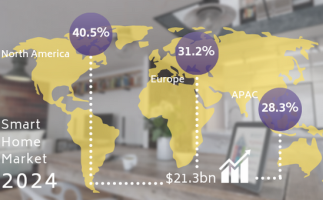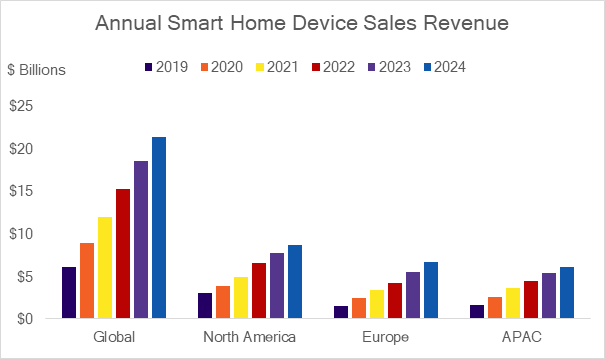CSP sales channels will be sidelined in US$21.3bn smart home device market by 2024, say Rethink analysts

In key geographic markets, smart home device sales will reach 356.3 million units annually in 2024, accounting for 80.2 million total smart homes. This represents an installed base of 1.33 billion smart home devices, with annual sales revenue of $21.3 billion (€18.99 billion) in 2024.
The average number of smart home devices per home will climb to 16.53 in the period, rising from 5.35, with North America holding 40.5% of the market in 2024, Europe on 31.2% and APAC holding 28.3%. In terms of compound annual growth rate (CAGR), the number of devices sold annually is projected to climb at 35.4% CAGR, with the cumulative install-base growing by 53.8% CAGR, and the total number of smart homes increasing at 22.7% CAGR.
The sales revenue for the devices will climb at 23.3% CAGR. For annual device sales, North America is expected to achieve a CAGR of 29.9%, with Europe on 42.5% and APAC on 37.7%. For the cumulative total, these are 50.3%, 56.2%, and 57.2% respectively.
This forecast is the next phase in Rethink’s research on the smart home market, building on our previous Smart Home as a Service (SHaaS) forecast, which modeled the opportunity for Communication Service Providers (CSPs) to embrace the consumer voice platforms from Google and Amazon in offering SHaaS packages – in key indicative markets in North America, Europe, and APAC. The CSPs collectively missed the opportunity to create their own smart home platforms, and now compete in a market where the consumer offerings comprise the bulk of shipments.

Smart home devices will vary in both price and capabilities through the period. A great example is the plummet in pricing for colored LED lights, as well as in-home surveillance cameras. Wyze sell cameras for $20 (€17.83), and the likes of Philips Hue and LIFX have seen cheap overseas rivals surge to the top of sales lists – such as Lohas, Ausein, and Teckin.
Every device in a smart home is at risk of being replaced by a much cheaper rival, but as per-device costs come down, the number of installed devices should rise. Lower per-device prices are only going to help overall adoption.
CSPs like Comcast, Deutsche Telekom and Orange, seem to have been most ambitious in pushing SHaaS packages, and will turn to Amazon and Google to try and cross-pollinate. Apple is another major platform, but has been very slow compared to its rivals. Other platform approaches can be found from Hive and Nest, both of which have a utility-focused angle.
Security service providers like ADT, Securitas, and Alarm.com are well-positioned to push SHaaS offerings, and insurance providers are taking greater interest in the potential for data-based pricing and devices that can intervene before an insurance claim escalates.
Away from the SHaaS angle, online retailers like Amazon and eBay, will flood the market with cheap devices, most of which will be used in the less mission-critical smart home roles, such as lights and sensors. The high-value applications, such as thermostats, cameras, and media experiences, will remain the main area that established brands can compete in, but there will be a significant race to the bottom in hardware pricing. Smart home devices have already reached the point where they can be casually plucked off the shelf during a weekly grocery shopping trip, and it is this price-point that is going to drive volume.
Comment on this article below or via Twitter @IoTGN
